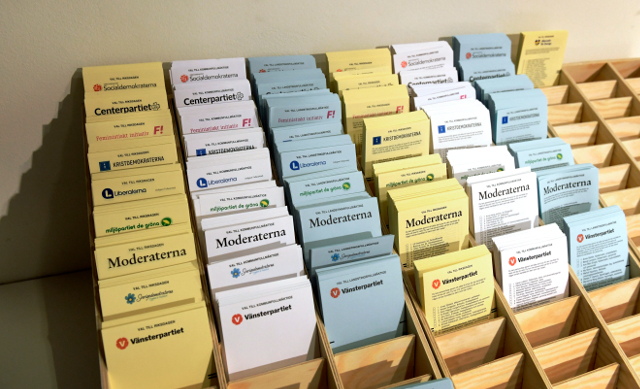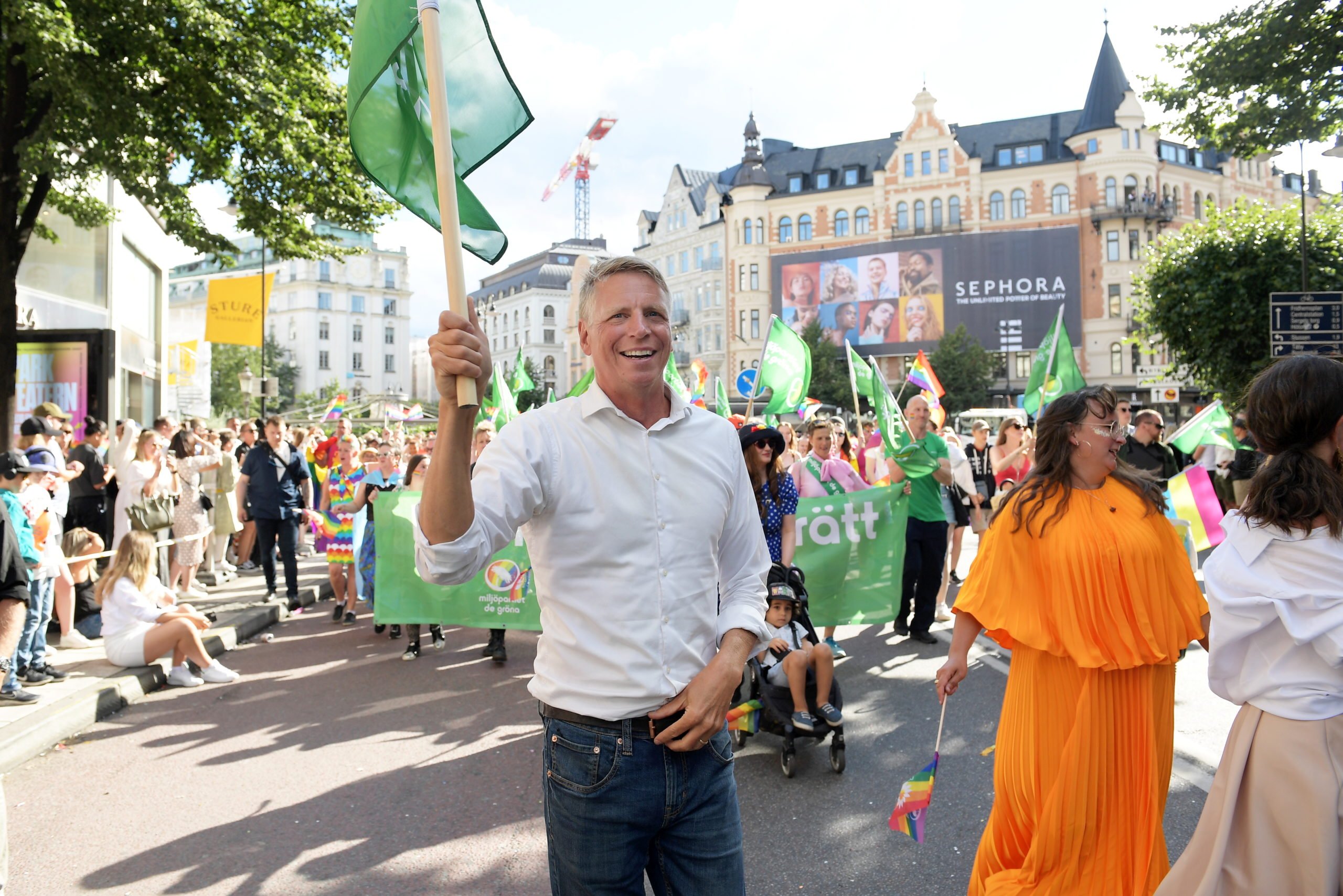Election vocabulary: How to talk about politics like a Swede

Can't tell your valfläsk from your partiledare? Let The Local guide you through the Swedish political vocabulary you should know to hold your own in a valdebatt.
This article is available to Members of The Local. Read more Membership Exclusives here.
The basics
The word for 'election' is val, which also means 'choice' and 'whale', just to make things extra confusing for Swedish learners. Sweden votes in three elections on the same day: riksdagsvalet (the election for the national parliament), landstingsvalet (the regional election) and kommunalvalet (the municipal election).
Swedish citizens over the age of 18 have rösträtt (right to vote). But although the national election tends to get more attention, non-citizens should know that you may still be able to rösta (vote) in the regional and local elections. If you're röstberättigad (eligible voter) you may have received a röstkort (voting card) in the mail.
READ ALSO: Can I vote in the 2022 Swedish election?

What röstsedlar (we'll explain this further down) might look like in Sweden. Photo: Janerik Henriksson/TT
The campaigning
The valkampanjer (election campaigns) are underway with the parties falling over themselves trying to present the most attractive vallöften (campaign promises) or, if you want to be more cynical, valfläsk (overly generous promises; literally election pork). In squares all over Sweden you will see valstugor (election huts, where party workers talk to voters about their policies), TV listings will be full of partiledardebatter (party leader debates) and if you're unlucky you may hear a number of floskler (empty phrases).
This campaign is quite populist in tone, so you might hear politicians denounce media commentators as proffstyckare (professional opinionators).

Green Party spokesperson Per Bolund takes part in this year's Pride Parade in Stockholm: Maja Suslin/TT
The voting
You will be able to förtidsrösta (vote in advance), from this week, but if you're more traditionally-minded you can also go to your designated röstlokal (polling station) on valdagen (the day of the election).
When you're there, you pick up the röstsedel (ballot paper) of your preferred parti (party) and put it in the valurna (ballot box). If you want you can also personrösta, which is when you tick the name of a specific candidate who you think should represent the party as riksdagsledamot (member of parliament).
Alternatively, people may choose to rösta blankt, which is when you do turn up at the polling station on the day, but instead of voting you put a blank slip of paper in the ballot box as a form of protest.
Sweden generally enjoys high valdeltagande (voter turnout). In the 2018 election more than 87 percent of eligible voters cast their vote.

Gustav Fridolin, former partiledare (party leader) of Miljöpartiet, taking part in förtidsröstning in 2018. Photo: Johan Nilsson/TT
The contenders
The ruling Socialdemokraterna (Social Democrats) have been ruling alone in a weak minority government since the Miljöpartiet (Green Party) last November left the two-party koalitionsregering (coalition government) that had been ruling Sweden for the past two mandatperioder (terms). In January 2019, they took power again, with the support of the Centerpartiet (Centre Party) and Liberalerna (Liberal Party) under the January Agreement.
The Liberal Party broke off the agreement in June, meaning the vänsterblocket (left bloc) consists of the Social Democrats, Greens, Left Party and Centre Party (which is normally seen as on the right).
Their traditional opponents are högern (the right wing), formerly referred to as de borgerliga (the bourgeois – which doesn't automatically have the same strong connotations in Swedish as in English).
In this election, though, they have teamed up with Sverigesdemokraterna (the Sweden Democrats), to form a new bloc which so far lacks an agreed name. Opposition leader Ulf Kristersson prefers to refer to them as maktskiftespartierna (the change in government parties), while the green party has taken to calling them de blåbruna (the blue-brown), a term that smears the Sweden Democrats as fascists.
READ ALSO: What sort of government might Sweden have after the election?

A partiledardebatt on Swedish television. Photo: Adam Ihse/TT
The future
According to opinionsundersökningar (opinion polls), there's unlikely to be a clear-cut winner, which means lengthy post-election förhandlingar (negotiations) and maybe blocköverskridande (bipartisan) compromises. Minoritetsregeringar (minority governments) are not uncommon in Sweden.
The talman (speaker of parliament) puts forward a proposal for a new statsminister (prime minister) to the new parliament, which votes for or against. More than half of Sweden's 349 MPs have to vote against the förslag (proposal) to reject it, but it does not need the explicit support of a majority. Opposition parties may therefore choose to lägga ner sina röster (abstain) to make the process run smoothly if they don't think that they themselves are strong enough to be able to bilda regering (form a government).
If the speaker's nominee for prime minister is rejected by parliament (as happened three times after the 2018 election), he or she can repeat the process four times. If parliament is still unable to reach an agreement on the next prime minister an extra val (a new election) will be held.
Can you think of any other Swedish political words? Let us know and we'll add them to the list.
Comments
See Also
This article is available to Members of The Local. Read more Membership Exclusives here.
The basics
The word for 'election' is val, which also means 'choice' and 'whale', just to make things extra confusing for Swedish learners. Sweden votes in three elections on the same day: riksdagsvalet (the election for the national parliament), landstingsvalet (the regional election) and kommunalvalet (the municipal election).
Swedish citizens over the age of 18 have rösträtt (right to vote). But although the national election tends to get more attention, non-citizens should know that you may still be able to rösta (vote) in the regional and local elections. If you're röstberättigad (eligible voter) you may have received a röstkort (voting card) in the mail.
READ ALSO: Can I vote in the 2022 Swedish election?

What röstsedlar (we'll explain this further down) might look like in Sweden. Photo: Janerik Henriksson/TT
The campaigning
The valkampanjer (election campaigns) are underway with the parties falling over themselves trying to present the most attractive vallöften (campaign promises) or, if you want to be more cynical, valfläsk (overly generous promises; literally election pork). In squares all over Sweden you will see valstugor (election huts, where party workers talk to voters about their policies), TV listings will be full of partiledardebatter (party leader debates) and if you're unlucky you may hear a number of floskler (empty phrases).
This campaign is quite populist in tone, so you might hear politicians denounce media commentators as proffstyckare (professional opinionators).

The voting
You will be able to förtidsrösta (vote in advance), from this week, but if you're more traditionally-minded you can also go to your designated röstlokal (polling station) on valdagen (the day of the election).
When you're there, you pick up the röstsedel (ballot paper) of your preferred parti (party) and put it in the valurna (ballot box). If you want you can also personrösta, which is when you tick the name of a specific candidate who you think should represent the party as riksdagsledamot (member of parliament).
Alternatively, people may choose to rösta blankt, which is when you do turn up at the polling station on the day, but instead of voting you put a blank slip of paper in the ballot box as a form of protest.
Sweden generally enjoys high valdeltagande (voter turnout). In the 2018 election more than 87 percent of eligible voters cast their vote.

Gustav Fridolin, former partiledare (party leader) of Miljöpartiet, taking part in förtidsröstning in 2018. Photo: Johan Nilsson/TT
The contenders
The ruling Socialdemokraterna (Social Democrats) have been ruling alone in a weak minority government since the Miljöpartiet (Green Party) last November left the two-party koalitionsregering (coalition government) that had been ruling Sweden for the past two mandatperioder (terms). In January 2019, they took power again, with the support of the Centerpartiet (Centre Party) and Liberalerna (Liberal Party) under the January Agreement.
The Liberal Party broke off the agreement in June, meaning the vänsterblocket (left bloc) consists of the Social Democrats, Greens, Left Party and Centre Party (which is normally seen as on the right).
Their traditional opponents are högern (the right wing), formerly referred to as de borgerliga (the bourgeois – which doesn't automatically have the same strong connotations in Swedish as in English).
In this election, though, they have teamed up with Sverigesdemokraterna (the Sweden Democrats), to form a new bloc which so far lacks an agreed name. Opposition leader Ulf Kristersson prefers to refer to them as maktskiftespartierna (the change in government parties), while the green party has taken to calling them de blåbruna (the blue-brown), a term that smears the Sweden Democrats as fascists.
READ ALSO: What sort of government might Sweden have after the election?

A partiledardebatt on Swedish television. Photo: Adam Ihse/TT
The future
According to opinionsundersökningar (opinion polls), there's unlikely to be a clear-cut winner, which means lengthy post-election förhandlingar (negotiations) and maybe blocköverskridande (bipartisan) compromises. Minoritetsregeringar (minority governments) are not uncommon in Sweden.
The talman (speaker of parliament) puts forward a proposal for a new statsminister (prime minister) to the new parliament, which votes for or against. More than half of Sweden's 349 MPs have to vote against the förslag (proposal) to reject it, but it does not need the explicit support of a majority. Opposition parties may therefore choose to lägga ner sina röster (abstain) to make the process run smoothly if they don't think that they themselves are strong enough to be able to bilda regering (form a government).
If the speaker's nominee for prime minister is rejected by parliament (as happened three times after the 2018 election), he or she can repeat the process four times. If parliament is still unable to reach an agreement on the next prime minister an extra val (a new election) will be held.
Can you think of any other Swedish political words? Let us know and we'll add them to the list.
Join the conversation in our comments section below. Share your own views and experience and if you have a question or suggestion for our journalists then email us at [email protected].
Please keep comments civil, constructive and on topic – and make sure to read our terms of use before getting involved.
Please log in here to leave a comment.